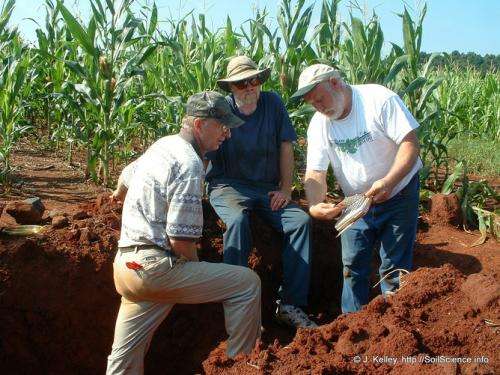Deep soils store up to five times more carbon than first thought, study finds

Deep soils store up to five times more carbon than is commonly reported, a new study by Murdoch University and Cranfield University in the UK has found.
Soil locks in greenhouse gases by storing carbon, making it a crucial player in the fight against global warming. Greenhouse gases are released when soils are exposed to air by farming, peat drainage and deforestation.
Current estimates of soil organic carbon are based largely on measurements to depths of 30 cm. This approach has evolved in North America and Europe, where soil is generally more shallow.
However, many plant species have roots extending many metres deep, suggesting there is also carbon stored at such depth and inspiring researchers to explore the storage potential of deeper soils in older landscapes such as the Amazon or Australia. Researchers in the Amazon had previously sampled soils to 8 m.
The researchers took soil measurements from samples taken to almost 40 metres deep at a range of sites in south-western Australia.
They found that small amounts of carbon were present throughout the soils all the way to the bedrock, and that deep soils store up to five times more carbon than is normally reported.
"This finding may have major implications for estimates of global carbon storage and modelling of the potential global impacts of climate change and land-use change on carbon cycles," the researchers said in their paper, which was published in the journal Plant and Soil.
Lead researcher Professor Richard Harper, an expert in water management and sustainability at Murdoch University said the findings extend our concept of the amounts and potential of carbon stored in soils.
"This carbon has been previously overlooked, and this opens up several lines of inquiry – for example, what happens to this carbon with land use change such as deforestation and reforestation?" Professor Harper said.
"There is likely more carbon stored in the world's soils than previously considered. What will happen to this carbon – that is, will it be released as a result of either land-use change or climate change – is unknown. This is what we are working on now," he said.
Landmark study
Professor of Horticulture and Viticulture at the University of Melbourne, Snow Barlow, said the study highlights the significant impact of land use change on global carbon cycles.
"This paper is a timely reminder of the impacts of land use change, as this carbon has clearly originated in the earlier forested era of these landscapes," said Professor Barlow, adding that Australia's position on the UN Kyoto Protocol climate change agreement was strongly based on the significance of land use change through decreasing land clearing.
"It is also a strong reminder of how much carbon is actually stored in soils, particularly deep soils, and that even Australia has deep soils that contain significant carbon at moderate rainfalls."
Dr Robert Edis, a soil scientist from the University of Melbourne said the study was "robustly and rigorously executed and then elegantly interpreted", but added that the importance of deep soil carbon for climate change, "hinges on how stable the carbon is, and will determine if the study is just interesting or pivotal."
Dr Edis said the study was a "landmark quantification of a pool of carbon only qualitatively suspected."
Andrea Koch, project manager of the Soil Carbon Initiative at the University of Sydney said the study highlights how much we have underestimated the potential for soils to act as a critical sink for carbon.
"As a society, we are pretty focused on what we can get from the top 30cm of the soil profile, and the mineral and energy resources that are deep below the surface, but the soil in between the deeper soil is a frontier that is yet to be understood. Managing and maintaining soil carbon is fundamental to food and water security, biodiversity and energy security, as well as climate regulation, so if we can work out ways to manage soil carbon at depth that can only be a good thing," Ms Koch said.
"Finding ways to manage and account for soil carbon at depth will not only require new soil management practices and technologies, it will also need to be met with public policies that support and encourage these efforts," she said.
Source: The Conversation
This story is published courtesy of The Conversation (under Creative Commons-Attribution/No derivatives).

















